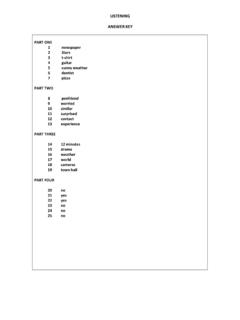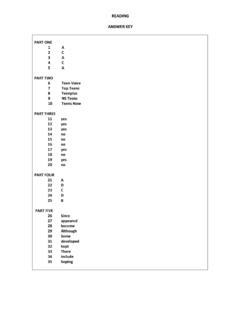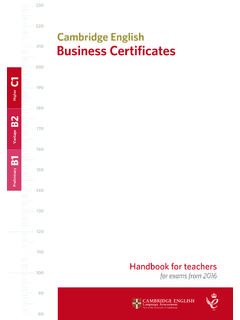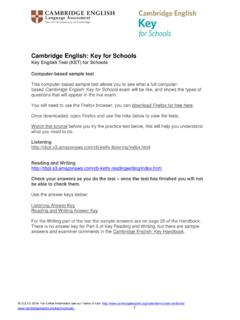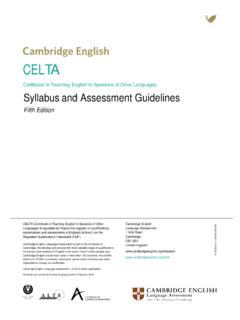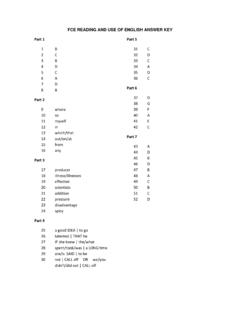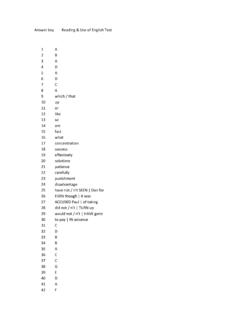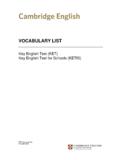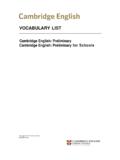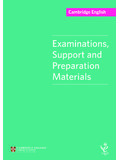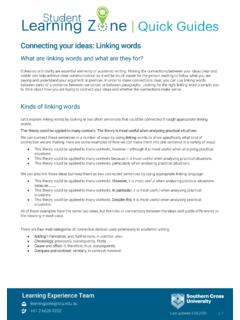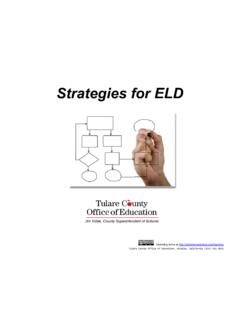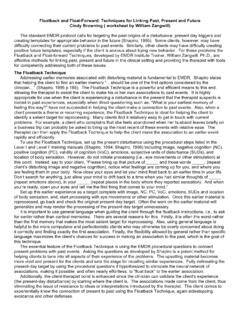Transcription of B2 First for Schools Reading part 6 self-access
1 1 B2 First for Schools Reading and Use of English Part 6 (Gapped text) Prepare to read. Prepare for exam success. Top tip! Read everything in English. Each task in this lesson requires you to conduct online research on websites that are written in English only. Don t translate the text! These tasks will help you to improve your ability to read and skim a text in English for the main idea, and also to read for detail - both skills that you already have in your First language, but which don t transfer automatically when you learn another language. Summary In this lesson you will: Practise Reading skills. Choose a text to read in English. Deduce the meaning of unfamiliar vocabulary from the surrounding context.
2 Read the text in more detail. Practise Reading part 6. Research task 1: Take an active interest In this lesson you are going to practise Reading stories from the BBC website. Tip! Use your strengths and interests to improve your understanding. We re usually more motivated to read something when we re genuinely interested in the topic. Before you read a whole text, just read the title and the beginning paragraph. Ask yourself: What do you already know about this topic? How do you feel about it? 1. The topic of this lesson is inventions. What do you think is the most useful invention of modern times? What about the least useful? Take some notes in your notebook of which invention(s) you think are most/least useful and why.
3 2. Now, for each of the following articles, read only the title and the First 4-5 sentences. Then choose one article which you find interesting, and which you will read in more detail. World wide web1 Mobile phone2 Plastic3 1 Invented in 1989, article published in 2019. 2 Invented in 1973, article published in 2010. 2 Reading task 1: Reading for gist Now that you have chosen the article which you find most interesting, quickly read the whole text (in approximately 2 minutes). You don t need to understand everything yet - just try to get the main idea. Tip! Just read quickly the First time. This Reading strategy gives you a general understanding of the ideas , style and structure of the text.
4 This helps your brain process the basic information First , so when you go back and look for more detail, you already have some knowledge of the text and it s easier to understand the details. Research task 2: Word attack strategies to deal with new vocabulary You ve probably noticed some unfamiliar vocabulary in the text. Now is your chance to find out what it means by attacking those words ! Here s one way to develop your vocabulary skills: 1. Make a note in your notebook of 3-4 words in the text which you don t know. 2. Now look more closely at these words in the text and, for each word: a. Focus on form: Look at the spelling of the word. Look at its parts.
5 Are there any parts which you recognise, even if you don t know the whole word? (For example, does the beginning or ending of the word suggest that it is a noun, a verb, an adjective, Check Cambridge Dictionary s page about word formation for help with this.) Does it look similar to a word which you know in another language?4 b. Focus on use: What words come immediately before and immediately after it? Do you recognise these words ? Do you think they add anything meaningful to the unknown word? Could there be more than one meaning? (For example, in the phrase green vehicles , this First word could refer to a colour or to something environmentally-friendly.) c. Focus on co-text: Read the whole sentence carefully.
6 Say it out loud. Now read the sentence immediately before this and the sentence immediately after this. What information do these sentences give? What would be logical or possible before / after this information? More detail about the same thing? Something positive? Something negative? A fact? An opinion? d. Focus on meaning: Now you have a clearer idea about this unknown word. What do you think it means? Do you know any synonyms? What happens if you try to replace the word with one of these synonyms? How do you think you would say this word in your First language? 3. Good detective work! First , make a note of your ideas . Then, look up the unknown word in the Cambridge Dictionary.
7 Were your guesses correct? 3 Invented in the early 1900s, article published in 2020. 4 This is a useful strategy, but be careful! Some words are borrowed from another language but the meaning or use is not the same in both languages. 3 Need help? Here is an example of how you might follow the four steps above, a-d. Imagine you read the following sentences in a text and you don t recognise the word in italics. I can t believe my friend keeps his pet fish in such a tiny bowl. The fish is absolutely humungous.
8 Surely it doesn t have enough space to swim in there! a. Focus on form: It ends with -ous. This is a typical adjective ending, and this word is describing a fish so I think humungous is an adjective. b. Focus on use: The word before it is absolutely and it s followed by an exclamation mark (!). I know phrases like absolutely amazing and absolutely terrified and these phrases both describe extreme things: very good and very scared. People use these phrases and punctuation to express something quite strong. So I think humungous is probably another extreme adjective. c. Focus on co-text: The previous sentence suggests the bowl is too small for the fish, and the following sentence suggests that the fish doesn t have enough space.
9 D. Focus on meaning: I guess that humungous probably means very big or huge. If I say The fish is absolutely huge this seems to have a similar meaning. Reading task 2: Reading for more detail You ve got the main idea of the text now, and you ve already started looking in more detail. Now it s time to read the whole text again more carefully and take brief notes on the main ideas . Try to see the text as a series of 6-7 connected ideas . Keep your notes short. Can you use just 2 or 3 words to summarise the main idea of each section? Research task 2: Text attack strategies to understand text structure Now you know the main ideas of the text and the overall structure.
10 You ve also looked at the meaning of some unfamiliar words . But a lot of the little words also do a very important job in the text by connecting ideas and making these connections clear for the reader. Choose 2-3 sections of the text which you found quite clear. Read these again and look for examples of connecting words and phrases, like these: words for avoiding repetition: it, they, him, her, this, that, these, those, which, one, in other words , etc. words for comparing, contrasting and connecting ideas : also, however, although, but, on the other hand, therefore, as a result, additionally, another, instead, after, while, etc. 4 Need help? Here s an example of how you might identify linking words in a text.
